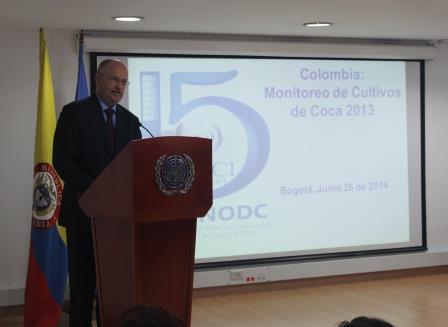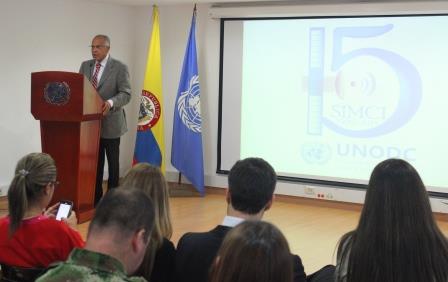UNODC 2013 survey: coca cultivation area unchanged in Colombia, prices and value of crop markedly down


26 June 2014 - The area used for the cultivation of coca plants in Colombia remained stable in 2013 compared to the previous year, according to the latest UNODC's coca crop survey. While there were some decreases in cultivated areas in several regions, this was offset by increases in others, leaving the net total of around 48,000 hectares unchanged. The production of coca leaves decreased 14 per cent due to lower yields per hectare.
The annual survey, produced jointly by UNODC and the Colombian Government, uses satellite imagery and field surveys to compile all the information related to the cultivation and eradication of coca crops in Colombia. The results showed that in areas such as the Central, Amazon and Orinoco regions there were decreases in the surface under coca cultivation of 15, 43 and 41 per cent, respectively. In others, like the Meta-Guaviare and Putumayo-Caquetá regions, and Norte de Santander and Nariño departments, there were increases of 16, 22, 41 and 23 per cent, respectively, which meant the national total was not affected. Government-led manual eradication and aerial spraying was carried out in 47,000 and 22,000 hectares, respectively.
The total farm-gate value of the coca leaf crop, and its derivatives (coca paste and cocaine base), was $313 million in 2013, a 18 per cent drop from the previous year's figure of $381 million. This amounts to 0.2 per cent of national GDP and 3 per cent of the share of GDP related to agriculture.
The number of households involved in the cultivation of coca leaf fell by 6 per cent, compared to 2012, to stand at 61,700. Continuing the downward trend seen since 2005, the average income per person involved in the cultivation and production of coca leaf, coca paste, or cocaine base dropped 13 per cent compared to 2012, and stood at around $1,000 per year.
Bo Mathiasen, UNODC representative in Colombia, underlined the importance of supporting the Colombian Government's efforts in strengthening the country's institutions, and its work on promoting alternative livelihoods in the areas affected by coca cultivation. "By helping to formulate and implement public policies which strengthen community organisational capacity and promote alternative development with a social, entrepreneurial and business vision, UNODC has contributed to increase the capacity of the State and that of civil society to fight against the illicit drugs problem."
From 2003 to 2013, alternative development programmes have benefited more than 156,000 households in 361 municipalities all over Colombia, promoting economic and social development in areas affected by illicit crops and within communities linked or at risk of being involved in this activity.
